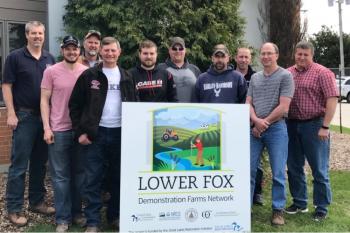On this page:
Objective, Commitments & Measures
Objective:
3.1. Reduce nutrient loads from agricultural watersheds to prevent harmful and nuisance algal blooms.
Commitments:
3.1.a. Implement systems of conservation practices on farms and in watersheds to reduce and prevent nutrient runoff.
3.1.b. Increase adoption of enhanced nutrient management practices through peer-to-peer learning and one-on-one assistance.
3.1.c. Support development, expansion and capacity of demonstration farms to reach new producers.
Measures:
| Measures of Progress With Annual Targets | Baseline/ Universe | FY2025 Target | FY2026 Target | FY2027 Target | FY2028 Target | FY2029 Target |
|---|---|---|---|---|---|---|
| 3.1.1. Estimated pounds of phosphorus reductions from conservation practice implementation. | 2,800,000/N/A | 3,100,000 | 3,400,000 | 3,700,000 | 4,000,000 | 4,300,000 |
| 3.1.2. Acres receiving technical or financial assistance on nutrient management in priority watersheds. | 2,150,000/10,000,000 | 2,300,000 | 2,450,000 | 2,600,000 | 2,750,000 | 2,900,000 |
| 3.1.3. Number of active demonstration farms created or sustained with GLRI funding. | 39/N/A | 43 | 46 | 49 | 52 | 55 |
"Targets" are cumulative. Activities throughout the Great Lakes watershed are counted, unless specified otherwise (as in 3.1.2, which is limited to the priority watersheds). "Baseline" for 3.1.1 is the FY24 Target. "Baseline" for 3.1.2 is the expected result for FY24. "Baseline" for 3.1.3 are the number of active GLRI demonstration farms as of FY24.
Background
Since GLRI began, more than 2 million pounds of phosphorus has been prevented from washing off farmlands and more than 2 million cropland acres are under improved nutrient management in agricultural priority watersheds. Runoff from agricultural lands is a significant source of excess nutrients in the Great Lakes and phosphorus in particular is critical to control because it is the biggest driver of harmful and nuisance algal blooms.
GLRI supports multiple activities to reduce phosphorus runoff and prioritized this work in the Maumee (Ohio), Saginaw (Michigan), Fox (Wisconsin) and Genesee (New York) River watersheds, which are the largest sources of phosphorus contributions. Efforts included farmer education and assistance to adopt conservation methods like soil testing, keeping the ground covered with plants year-round and planting seeds and applying fertilizer while minimally disturbing the soil. In addition, conservation practices were implemented beyond farm fields — at the edge of fields, along streams and throughout watersheds.
Since GLRI began, the number of farmland acres enrolled in voluntary conservation programs in the Great Lakes watershed has more than doubled. Under GLRI Action Plan III, conservation practices were targeted to expand the adoption of nutrient management — which is managing the amount, placement and timing of fertilizer applications to minimize runoff. By leveraging GLRI with other Natural Resources Conservation Service programs, farmers improved their nutrient management on 800,000 acres in priority watersheds. Continued support for conservation planning and assistance will be vital to sustaining and expanding on these accomplishments.
GLRI also supported farmer-led innovation. GLRI demonstration farm networks, created through agreements with local conservation partners, showcase management practices that prevent nutrient runoff from farmlands. The participating farms host field days and tours for neighboring farms and resource professionals to share their successes and lessons learned in adopting new practices. Outreach and peer-to-peer learning motivate other farmers to try these approaches.
Under GLRI Action Plan IV, GLRI federal agencies and their partners will continue to support direct farmer assistance and outreach to reduce nutrient losses in agricultural watersheds as well as continue to strategically target and design projects based on the latest science. Specifically, GLRI federal agencies and their partners will:
- Expand outreach and demonstration farm networks to improve adoption of on-farm nutrient management practices, with an emphasis to include a broader range of farm types, such as smaller farms, vegetable and grazing farms.
- Increase technical expertise and capacity at the local level to promote peer-to-peer learning and one-on-one assistance. Activities may include maintaining or adding expert staff at the county conservation districts in priority watersheds, or engaging other trusted farmer advisers such as nutrient management planners.
- Support practices that slow down and filter agricultural stormwater runoff, such as expanding buffers to waterways, widening floodplains on drainage ditches and creating wetlands in receiving waterbodies that can also contribute to reductions in flooding and erosion.
Research tells us that focusing our efforts on in-field practices alone is not enough to meet phosphorus reduction goals. Improved nutrient management on farm fields, coupled with filtering practices at the edge of fields and in areas of high legacy1 phosphorus, is needed to further reduce nutrient runoff.
1 Here legacy phosphorus refers to the accumulation of phosphorus in farm fields or deposited in streambeds and streambanks.
Continue reading about the Action Plan IV:





